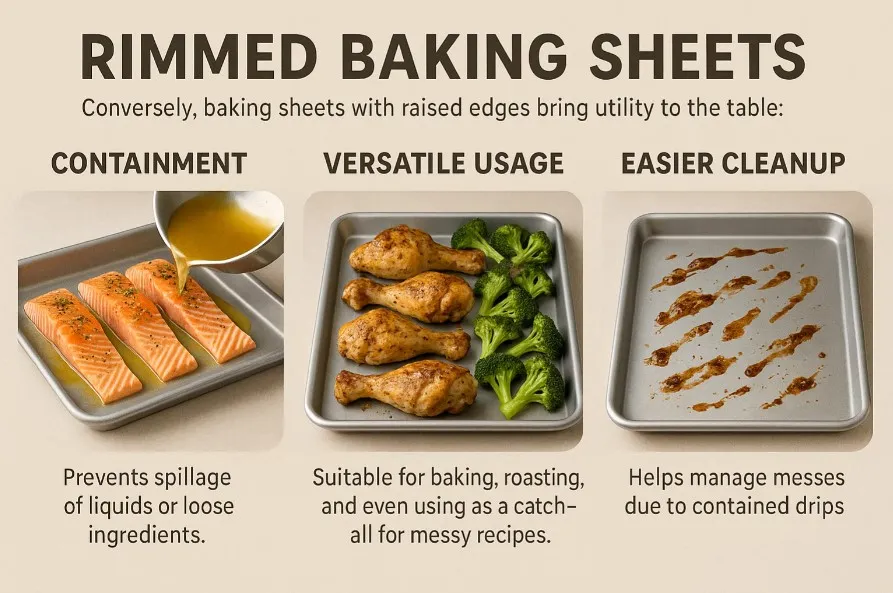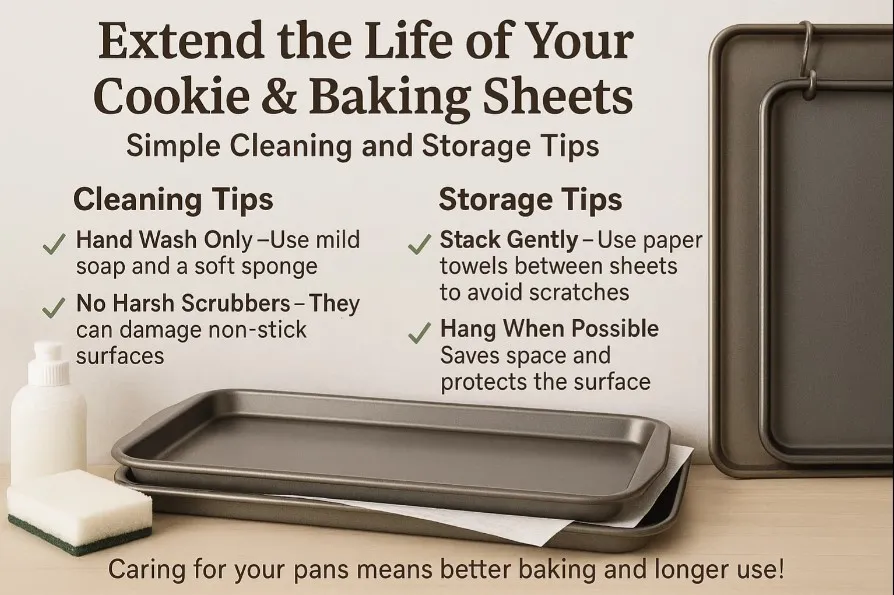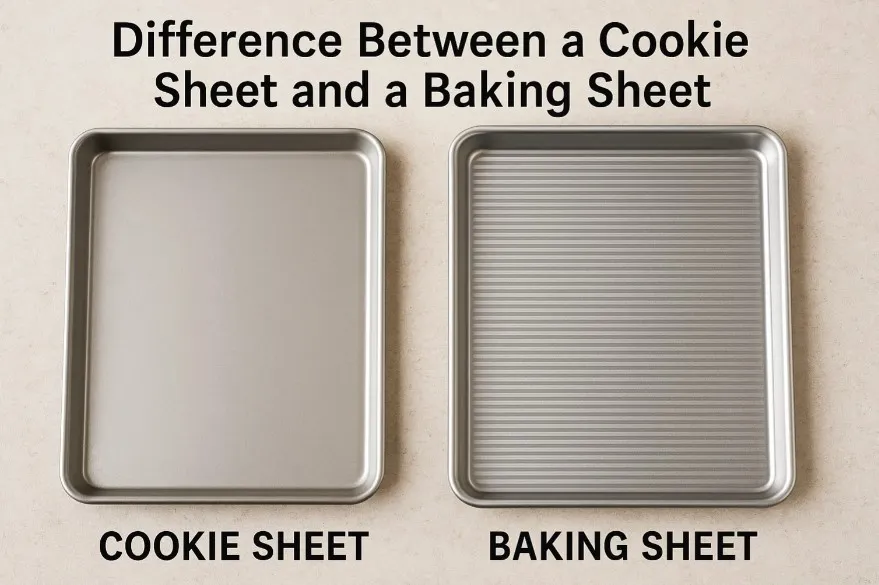The main difference is that a cookie sheet has no raised edges (or just a slight lip), making it ideal for sliding cookies off easily, while a baking sheet has raised edges on all sides, perfect for roasting veggies or baking foods with juices.
When it comes to baking, having the right tools can make all the difference in achieving delicious results. One common question that arises among amateur bakers and seasoned chefs alike is: What is the difference between a cookie sheet and a baking sheet?
This article aims to explore the distinct characteristics, uses, and advantages of both types of sheets, ensuring you are well-equipped for your next culinary adventure.
“A good baker knows the right tool makes all the difference. Cookie sheets and baking sheets each have their place in the kitchen.” – Julia Child
Cookie Sheet vs. Baking Sheet: Unveiling the Key Differences

In the world of baking, “cookie sheets” and “baking sheets” are terms often used interchangeably, but they are not quite the same. Understanding their specific features and functions will help you select the right sheet for your baking endeavors.
Cookie sheets are designed primarily for baking cookies, featuring a flat surface with low or no sides. This design allows for even heat distribution and easy access to the baked goods. On the other hand, baking sheets come with raised edges, which makes them versatile for various cooking tasks beyond just baking cookies.
The differences extend into practical applications, material choices, and overall performance in the kitchen. Let’s dive deeper into these distinctions.
Design Features of Cookie and Baking Sheets
The physical structure of cookie sheets and baking sheets plays a crucial role in their functionality.
Cookie Sheet Features
Cookie sheets typically have a large flat surface and minimal to no sides, allowing for optimal air flow around the cookies as they bake. This design prevents steam from building up, leading to crispier edges and a perfectly baked interior.
- Flat Surface: The lack of sides enhances airflow.
- Material Options: Most are made of aluminum or non-stick materials.
- Size Variations: They usually come in standard sizes like half-sheet or quarter-sheet.
With cookie sheets, the goal is to facilitate an uninterrupted baking experience, ensuring that cookies slide off easily once baked while maintaining their shape.
Baking Sheet Features
Baking sheets, often referred to as rimmed or jelly roll pans, feature raised edges that contain any drippings or batter. This design makes them suitable for a variety of recipes, from roasting vegetables to baking lasagna.
- Raised Edges: These prevent spills and keep ingredients contained.
- Material Variety: Available in aluminum, stainless steel, and more.
- Versatile Sizes: Offered in multiple dimensions for different oven configurations.
Baking sheets cater to diverse culinary tasks, meaning they can handle everything from basic baking to complex one-pan meals.
Heat Distribution and Performance: Comparing Cookie and Baking Sheets in Action
Effective heat distribution is vital for successful baking. Both cookie and baking sheets have unique designs that influence how they conduct heat, impacting the final outcome of your baked goods.
Cookie Sheet Heat Dynamics
A cookie sheet’s flat surface allows for even heat transfer across the entire area. This is crucial when aiming for uniform browning and temperature consistency. As hot air circulates, cookies bake evenly, minimizing the risk of burnt edges or undercooked centers.
- Quick Heating: Absorbs and distributes heat rapidly.
- Crispy Results: Ideal for achieving that desirable crunchy texture.
- Less Retention: Flat surfaces cool down faster, preventing over-baking.
Understanding how cookie sheets function helps bakers optimize their techniques, ensuring perfect cookies every time.
Baking Sheet Heat Dynamics
With their rimmed edges, baking sheets can hold onto retained heat, which may be beneficial for certain dishes. However, they can also create a slightly uneven cooking environment, particularly if the pan is overcrowded.
- Heat Retention: Keeps foods warm longer after removal from the oven.
- Multi-functionality: Works well for roasting meats and vegetables.
- Potential Hot Spots: Must be monitored to avoid uneven cooking.
Bakers should consider the purpose of their dish when choosing between a cookie sheet and a baking sheet, keeping in mind how each influences baking performance.
“The right pan can turn a good baker into a great one. Choose wisely!” – Martha Stewart
Edge Matters: How Rimmed and Rimless Designs Impact Baking Outcomes
The presence or absence of edges on baking sheets significantly affects cooking behavior and outcomes.
Rimless Cookie Sheets
Cookie sheets, with their rimless design, offer several advantages:
- Easy Access: Cookies can slide off easily, allowing for quick removal.
- Uniform Airflow: Lack of edges promotes even heat circulation.
- Ideal for Cookies: Perfect for achieving that lightness and crunch.
This design is crafted specifically for cookie baking, making it ideal for home bakers who want to achieve those classic cookie results.
Rimmed Baking Sheets

Conversely, baking sheets with raised edges bring utility to the table:
- Containment: Prevents spillage of liquids or loose ingredients.
- Versatile Usage: Suitable for baking, roasting, and even using as a catch-all for messy recipes.
- Easier Cleanup: Helps manage messes due to contained drips.
Understanding these edge dynamics enables bakers to select the appropriate sheet for their intended baking or cooking method, leading to optimal results.
Material Matters: Aluminum, Stainless Steel, and Other Options Compared
The choice of material can profoundly impact the performance of cookie sheets and baking sheets. Let’s explore some of the available options.
Aluminum Cookie Sheets
Aluminum is a popular choice for cookie sheets and offers numerous benefits.
- Lightweight: Easy to handle and maneuver.
- Excellent Heat Conductivity: Evenly distributes heat for consistent baking.
- Durability: Resists warping at high temperatures.
Aluminum cookie sheets are a staple in many kitchens due to their effectiveness in producing crispy cookies.
Stainless Steel Baking Sheets
Stainless steel offers its own set of advantages for baking sheets.
- Rust-Resistant: Ensures longevity and durability.
- Non-Reactive: Safe for all types of food.
- Heavy-Duty Construction: Typically thicker than aluminum, providing added stability.
While they may take longer to heat, stainless steel baking sheets are incredibly durable and ideal for a variety of cooking methods.
Ideal Uses for Cookie Sheets: Beyond Cookies, Explore Culinary Applications
While cookie sheets are primarily associated with baking cookies, their versatility extends beyond this traditional use.
Versatile Applications
- Roasting Nuts: The flat surface allows for even roasting.
- Toasting Breadcrumbs: Perfect for giving breadcrumbs that desirable crunch.
- Making Crackers: Ideal for baking homemade crackers without edges hindering the process.
These alternative uses demonstrate the cookie sheet’s flexibility, making it a valuable tool in any baker’s arsenal.
Baking Sheet Versatility: From Roasting Vegetables to Sheet Pan Dinners
Baking sheets are true workhorses in the kitchen, providing unmatched versatility for various culinary tasks.
Diverse Applications
- Roasting Vegetables: The raised edges contain juices and allow for flavorful caramelization.
- Sheet Pan Dinners: A single baking sheet can hold proteins, vegetables, and starches for complete meals.
- Baking Cookies: While less common, they can still effectively bake cookies when necessary.
The adaptability of baking sheets makes them indispensable for anyone looking to simplify meal preparation while maximizing flavor.
Choosing the Right Sheet: Factors to Consider Based on Your Baking Needs
Selecting the right sheet can greatly affect your baking success. Here are key factors to consider:
Purpose of Use
- Type of Dish: Determine whether you’ll be baking cookies, roasting veggies, or preparing a full meal.
- Batch Size: Larger batches might require multiple baking sheets or larger sizes.
Your specific needs will dictate the appropriate choice between a cookie sheet and a baking sheet.
Heat-Conducting Properties
- Material: Choose based on whether you want rapid heat conduction (aluminum) or durability (stainless steel).
- Cooking Methods: Some materials perform better under specific conditions, such as high heat versus moderate baking.
Understanding these properties helps ensure you invest in the best tools for your craft.
Care and Maintenance: Extending the Lifespan of Your Cookie and Baking Sheets

Proper care is essential for prolonging the life of your cookie sheets and baking sheets.
Cleaning Techniques
- Hand Washing: Opt for gentle scrubbing with mild detergent and a soft sponge.
- Avoid Abrasive Cleaners: These can scratch non-stick coatings and damage metal surfaces.
Regular maintenance contributes to performance consistency and aids in preserving the finish and integrity of your pans.
Storage Tips
- Stacking Carefully: Avoid stacking unless padded to prevent scratches.
- Hanging Options: If possible, hang sheets to save space and prevent wear.
Taking care of these details enhances your baking experience and ensures longevity.
Common Baking Mistakes and How the Right Sheet Pan Can Help
Even skilled bakers can encounter pitfalls during baking. The right sheet can minimize mistakes and improve results.
Overcrowding the Sheet
- Impact on Heat Distribution: Too many items can block airflow; using separate sheets can aid in even cooking.
- Uneven Cooking: It leads to undercooked centers or burnt edges.
Choosing the appropriate sheet size is essential for managing batch sizes effectively.
Ignoring Material Characteristics
- Incorrect Material Use: Using non-stick coatings improperly can lead to sticking or burning.
- Not Preheating: Some materials benefit from preheating; failing to do so can affect cooking times.
Being mindful of these aspects helps maintain consistency in baking outcomes.
Frequently Asked Questions for Difference Between a Cookie Sheet and a Baking Sheet
1. Can I use a baking sheet instead of a cookie sheet?
Yes, but cookies may bake slightly differently due to the edges trapping heat.
2. Are aluminum and stainless steel sheets different?
Aluminum heats up faster, while stainless steel is more durable but may have hot spots.
3. Do I need both in my kitchen?
If you bake often, having both is helpful. But a baking sheet is more versatile if you need just one.
Tips for Choosing the Best Sheet
- Material: Aluminum is great for even baking; stainless steel lasts longer.
- Size: A standard half-sheet pan (18×13 inches) fits most ovens.
- Non-stick vs. uncoated: Non-stick is easier to clean, but uncoated gives better browning.
“The right pan can turn a good baker into a great one. Choose wisely!” – Martha Stewart
Conclusion
The question of what is the difference between a cookie sheet and a baking sheet? is rooted in understanding their unique designs, uses, and impacts on cooking. By comprehending the features that differentiate cookie sheets from baking sheets — such as their structural designs, heat distribution properties, and material qualities — you can make informed decisions tailored to your baking needs. Ultimately, investing in the right tools sets the stage for delicious creations and enjoyable baking experiences.

